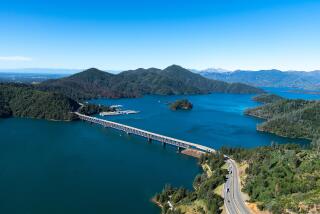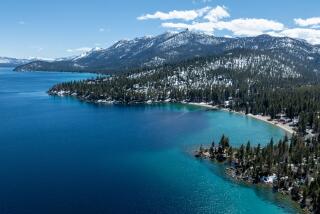Great Salt Lake Level Falls to 22-Year Low
- Share via
SALT LAKE CITY — The Great Salt Lake isn’t as great as it used to be.
Lack of precipitation and a hot summer have caused the lake’s level to recede sharply. It is now at 4,198 feet above sea level, the lowest since 1980.
Wallace Gwynn, a geologist for the Utah Geological Survey, predicted that the trend will bottom out this year about Dec. 1 at 4,197.15 feet. The last time it was that low was in 1972.
Boaters, particularly those on Antelope Island, are concerned that if the decline continues, there soon won’t be enough water to launch off the harbor without major modifications.
John Sullivan, assistant park manager at Antelope Island, said the marina water level is down 2 feet from last year.
“We’re almost in a drastic situation now,” he said. The ends of the docks have only 2-foot-deep water levels now, and that won’t handle some sailboats and certainly not large brine shrimp boats that arrive in October.
As recently as 15 years ago, massive pumps were used to try to keep Interstate 80 from flooding and to reclaim the Antelope Island causeway and other land from high water that caused about $250 million in damage.
The lake normally falls each year from summer into late fall before lower temperatures and moisture raise it in the winter and spring.
The lake’s historic peak came during flood years of 1986 and 1987 at 4,212 feet. Its all-time low on record, 4,191.35 feet, was in 1963.
Because it’s such a shallow lake, even minor drops expose much more land around the lake.
At 4,200 feet, the lake covers 1,700 square miles. At its 1963 record low, it covered only 950 square miles, while at its 1986-87 high, it expanded to 3,300 square miles.
Gwynn said low lake levels, to a point, are a boost to lake industries such as brine shrimp harvesters and salt and chemical extractors. Low levels concentrate chemicals and salt while creating ideal conditions for brine shrimp.
But if the lake keeps dropping, industries might have to deepen canals and brine shrimpers may have trouble launching.
Still another effect may be increased odor. “Lake stink,” the odor of decaying material around the lake’s edge, is blown to eastern communities when the winds carry it.
More to Read
Sign up for Essential California
The most important California stories and recommendations in your inbox every morning.
You may occasionally receive promotional content from the Los Angeles Times.













